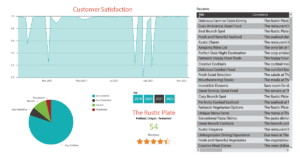Power BI has some fascinating AI capabilities and integrations that can enhance your data analysis significantly. Below are some of these AI features.
- Natural Language Query (Q&A): One of the amazing AI features in Power BI is Q&A, which allows you to ask questions about your data in natural language. For example, let’s say you are analyzing sales data for an e-commerce store. You could simply type, “What were the total sales in the last quarter?” and Power BI would display a visual with the relevant information. This feature enables users to interact with data intuitively and find insights quickly.
- Quick Insights: Power BI can automatically discover interesting patterns, trends, and outliers in your data using its built-in “Quick Insights” feature. For instance, if you are examining regional sales data, Power BI can identify regional differences for a particular product or service. This can help you identify potential growth or problem areas and take prompt action to address any potential issues or capitalize on newfound opportunities.

- Built-in AI visuals – Key Influencers: Power BI provides built-in AI visuals to help users identify critical factors that impact a specific metric. For example, you’re analyzing customer churn data for a telecom company. Using the “Key Influencers” visual, you can quickly identify customer demographics, plan type, and customer service interactions that influence customer churn rates. This powerful visual will help you focus on the most important variables and drive better decision-making.
- Integration of AI Models – Azure Machine Learning: Power BI can seamlessly integrate with Azure Machine Learning, enabling you to add powerful, custom-made AI models to your reports and dashboards. For instance, you might want to predict next month’s revenue based on factors like historical sales data, customer behavior, and seasonal trends. By connecting your Power BI report to an Azure Machine Learning model, you can make these predictions with increased accuracy, helping you plan your business strategies more effectively.
- Sentiment Analysis with Azure Cognitive Services: By integrating Power BI with Azure Cognitive Services, you can perform sentiment analysis on textual data like customer reviews, social media comments, and more. For example, if you run a restaurant chain, analyzing customer feedback is crucial for making improvements. Power BI can use sentiment analysis to determine the overall sentiment of each review, classifying it as positive, negative, or neutral. Visualizing this data in a dashboard lets you quickly identify trends and areas where your business can improve.

Through the use of these AI capabilities and integrations, Power BI can provide deeper insights, help you make informed decisions, and drive better results for your business.